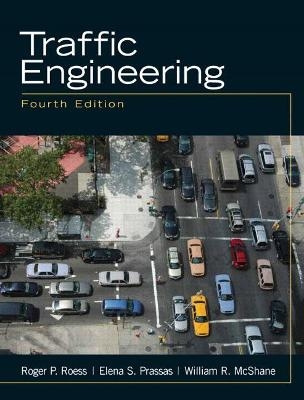
Traffic Engineering
Pearson (Verlag)
978-0-13-613573-9 (ISBN)
- Titel erscheint in neuer
- Artikel merken
This unique text focuses on the key engineering skills required to practice traffic engineering in a modern setting. It includes material on the latest standards and criteria of the Manual on Uniform Traffic Control Devices (2003 Edition and forthcoming 2010 Edition), the Policy on Geometric Design of Highways and Streets (2004 Edition), the Highway Capacity Manual (2000 Edition and forthcoming 2010 Edition), and other critical references. It also presents both fundamental theory and a broad range of applications to modern problems.
Dr. Roger P. Roess is Department Head in the Department of Civil Engineering at Polytechnic Institute of NYU. Elena S. Prassas is an Associate Professor in the Department of Civil Engineering at Polytechnic Institute of NYU. She earned her Doctor of Philosophy and Master of Science from Polytechnic University, and her Bachelor of Arts from the State University of New York, Oneonta. She is a Member of TRB's Highway Capacity and Quality of Service Committee (HCQSC), the Chair of the HCQSC Signalized Intersection Subcommittee, and a Member of both the ITE and WTS. William R. McShane is the Vice President of Operations and Dean of Engineering at Polytechnic University. He earned his B.S.E.E from Manhattan College and his M.S. and Ph.D. In Systems Engineering from Polytechnic University. His areas of interest include quality control, controls and simulation, and engineering economics.
Contents
Preface xiii
1 Introduction to Traffic Engineering 1
1.1 Traffic Engineering as a Profession 1
1.1.1 Safety: The Primary Objective 1
1.1.2 Other Objectives 2
1.1.3 Responsibility, Ethics, and Liability in Traffic Engineering 2
1.2 Transportation Systems and Their Function 3
1.2.1 The Nature of Transportation Demand 4
1.2.2 Concepts of Mobility and Accessibility 5
1.2.3 People, Goods, and Vehicles 6
1.2.4 Transportation Modes 6
1.3 Highway Legislation and History in the United States 8
1.3.1 The National Pike and the States’ Rights Issue 8
1.3.2 Key Legislative Milestones 9
1.3.3 The National System of Interstate and Defense Highways 11
1.4 Elements of Traffic Engineering 12
1.5 Modern Problems for the Traffic Engineer 13
1.6 Standard References for the Traffic Engineer 14
1.7 Metric versus U.S. Units 15
1.8 Closing Comments 15
References 15
Part 1 Traffic Components and Characteristics 16
2 Road User and Vehicle Characteristics 17
2.1 Overview of Traffic Stream Components 17
2.1.1 Dealing with Diversity 17
2.1.2 Addressing Diversity through Uniformity 18
2.2 Road Users 18
2.2.1 Visual Characteristics of Drivers 19
2.2.2 Important Visual Deficits 20
2.2.3 Perception-Reaction Time 20
2.2.4 Pedestrian Characteristics 22
2.2.5 Impacts of Drugs and Alcohol on Road Users 24
2.2.6 Impacts of Aging on Road Users 25
2.2.7 Psychological, Personality, and Related Factors 25
2.3 Vehicles 25
2.3.1 Concept of the Design Vehicle 26
2.3.2 Turning Characteristics of Vehicles 27
2.3.3 Braking Characteristics 29
2.3.4 Acceleration Characteristics 30
2.4 Total Stopping Distance and Applications 31
2.4.1 Safe Stopping Sight Distance 31
2.4.2 Decision Sight Distance 32
2.4.3 Other Sight Distance Applications 33
2.4.4 Change (Yellow) and Clearance (All Red) Intervals for a Traffic Signal 33
2.5 Closing Comments 33
References 33
Problems 34
3 Roadways and Their Geometric Characteristics 35
3.1 Highway Functions and Classification 35
3.1.1 Trip Functions 35
3.1.2 Highway Classification 36
3.1.3 Preserving the Function of a Facility 38
3.2 Introduction to Highway Design Elements 39
3.2.1 Horizontal Alignment 39
3.2.2 Vertical Alignment 39
3.2.3 Cross-Sectional Elements 40
3.2.4 Surveying and Stationing 40
3.3 Horizontal Alignment of Highways 40
3.3.1 Quantifying the Severity of Horizontal Curves: Radius and Degree of Curvature 40
3.3.2 Review of Trigonometric Functions 41
3.3.3 Critical Characteristics of Horizontal Curves 41
3.3.4 Superelevation of Horizontal Curves 44
3.3.5 Spiral Transition Curves 47
3.3.6 Sight Distance on Horizontal Curves 51
3.3.7 Compound Horizontal Curves 52
3.3.8 Reverse Horizontal Curves 52
3.4 Vertical Alignment of Highways 53
3.4.1 Grades 53
3.4.2 Geometric Characteristics of Vertical Curves 56
3.4.3 Sight Distance on Vertical Curves 58
3.4.4 Other Minimum Controls on Length of Vertical Curves 59
3.4.5 Some Design Guidelines for Vertical Curves 59
3.5 Cross-Section Elements of Highways 60
3.5.1 Travel Lanes and Pavement 60
3.5.2 Shoulders 61
3.5.3 Side-Slopes for Cuts and Embankments 61
3.5.4 Guardrail 61
3.6 Closing Comments 62
References 63
Problems 64
4 Introduction to Traffic Control Devices 65
| Erscheint lt. Verlag | 19.8.2010 |
|---|---|
| Sprache | englisch |
| Maße | 209 x 249 mm |
| Gewicht | 1310 g |
| Themenwelt | Technik ► Bauwesen |
| ISBN-10 | 0-13-613573-0 / 0136135730 |
| ISBN-13 | 978-0-13-613573-9 / 9780136135739 |
| Zustand | Neuware |
| Informationen gemäß Produktsicherheitsverordnung (GPSR) | |
| Haben Sie eine Frage zum Produkt? |
aus dem Bereich



